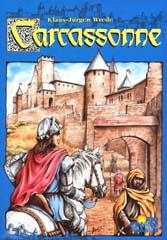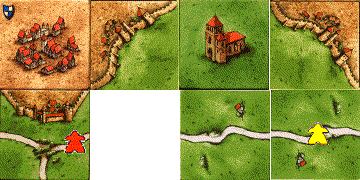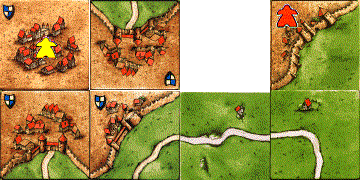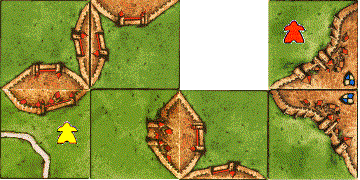
|
| Courtesy of Funagain Games |
In this review, first I will go over the rules briefly, then I will discuss some positive and negative aspects about the game, and finally I will discuss some game strategies. Assuming you are somewhat familiar with the game, I will go over the rules briefly. Carcassonne is a tile-laying game for 2 to 5 players. The theme surrounds the French mediaeval walled city of Carcassonne, but in game play it is similar to pipe laying or track laying games. On a turn, each player selects a tile randomly and places it abutted to the previously played tiles. After placing a tile, the player may place an optional follower on the tile in one of the tile regions: field, road, city, or cloister. As each player has only 7 followers, or "meeples" or "dudes" as they have affectionately been named, the scoring opportunities are extremely limited. Once a region is complete, it will score points for the player with most numerous followers in the region. The player with the most points wins the game.
The points scoring system is the heart of the game and the play balance. A road scores 1 point per tile. A cloister scores 1 point per tile for itself and all adjoining tiles for a maximum of 9 points. An incomplete town scores 1 point per tile or shield symbol, but completing it doubles this value. Farms do not score points per-say. However, completed towns score 4 points for the player with the most adjoining farmers. This has been a point of confusion among many beginning players, so it is best to look at each completed town and count adjoining farmers to figure these scores. Aside from farms which are not scored until the end of the game, completing a region returns your follower to your stock pile for further play and scoring.
My opinion of the game is that it is a bargain and has very high replay value. It plays well with either 2 players or up to its stated maximum of 5 players. It is short enough that it can be played 2 or 3 times in the course of an evening. There are multiple paths to victories, and games can be won through farms, cities, or cloisters. There are both offensive and defensive plays. It is liked by both beginners and experienced players. As you can see, I highly recommend it and mince no words about liking it.
| Carcassonne Expansion Tile Distribution | ||||||||||||||||||||||||||||||||||||||||||
| ||||||||||||||||||||||||||||||||||||||||||
|
Game by Klaus-Jürgen Wrede, Artwork by Doris Matthaus, Layout by Dan Becker Update 2002/05/25: This table shows the Carcassonne Expansion tiles. Update 2002/05/25: See the easy-to-print chart. |
Other detractors say the cloisters or the farms are too highly valued. However, the counter argument to this complaint is that every potential scoring play has its counter-move. For instance, let's say someone with a lot of farmers is completing many small cities for a score of 4 points each. In this case a player should play tiles such that cities cannot be completed so easily. An alternative strategy would be to place more farmers to directly challenge the farmer majority. A third strategy would be to use roads to dissect and limit the developing farm. In many plays of the game, I have seen almost an equal number of wins to the master of cloisters, farms, and cities. No simple pursuit of one of these regions is a guaranteed win. A player must usually balance these scorings or somehow shut the other scoring avenues down.
Which brings us to the third part of this review, basic game strategy. The first basic rule is to be aware of the remaining tiles. The table at right, suitable for printing and placing in your wallet, shows how many of each tile are available. (Note: The table has been updated to show the Carcassonne and Expansion tiles. The new tiles are shown with a gray background.) There is no sense in hoping for a 4 sided city tile when the only one of its kind has already been played. Another often wished for tile is the three sided city, with or without a road. This is a somewhat scarce tile, yet players often waste many turns waiting and hoping for its arrival. Don't wait for it. Move on to other scoring opportunities.
Another important rule is don't become follower-constrained. If your seven "meeples" are out on the board, and you are making moves without placing more followers, it is time to think about bringing your "dudes" home. Often the highest scores are achieved by having a good follower turn over: placing them out for future scores and completing regions to bring them home. If too many followers are invested in farms, or you have too many battling for mega-cities, you run the risk of having too many eggs in one basket. A series of small continuous scores can be preferable to that all-or-nothing giant farm battle at the end.
Another area of winning strategy is to know how to be a good weasel! For each of the major regions, know how to place tiles and "meeples" to horn in on other peoples winnings. Our group does this so much, we have many names for this tactic: "weaseling", "prying in", "shoe-horning" and plain old "stealing." Here are a few examples.

|
| Weasling a road |

|
| Shoe horning in on a city |

|
| Helping your fellow farmers |
So with all the examples, I hope you see why this is an enjoyable game. There are many choices to ponder and each tile yields 5 or 10 possible plays on the edges of the town. The addition or placement of a follower adds more decisions and fun. Very quickly the game gets up to speed, the areas form, and it all becomes a big strategic puzzle to solve. There are thrusts and parries, and then it all ends in less than 45 minutes. If you think luck has abandoned you, it is quick enough that you can play it again, but beware, some players are still complaining about their luck after 10 games. All in all, this is an excellent game that is well designed. Highly recommended.
Update 2002/05/25: See the Lost Tiles of Carcassonne article.
Update 2002/05/25: See the Carcassonne Expansion Review.
Update 2002/05/25: See the easy-to-print Carcassonne Expansion tile distribution.
Update 2002/11/26: See the Carcassonne: Hunter and Gatherers tile discussion.